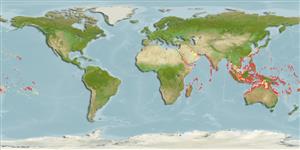Lobophyllia corymbosa (Forsskål, 1775)
Brain root coral| Native range | All suitable habitat | Point map | Year 2050 |

|
| This map was computer-generated and has not yet been reviewed. |
| Lobophyllia corymbosa AquaMaps Data sources: GBIF OBIS |
Classification / Names Common names | Synonyms | CoL | ITIS | WoRMS
Hexacorallia | Scleractinia | Lobophylliidae
Environment: milieu / climate zone / depth range / distribution range Ecology
Reef-associated; depth range 0 - 35 m (Ref. 8294). Tropical; 36°N - 26°S, 32°E - 119°W (Ref. 848)
Distribution Countries | FAO areas | Ecosystems | Occurrences | Introductions
Indo-Pacific: East Africa including Red Sea, to Polynesia, north to Japan and south to Australia.
Length at first maturity / Size / Weight / Age
Maturity: Lm ? range ? - ? cm Max length : 100.0 cm COLD male/unsexed; (Ref. 269)
Short description Morphology
Formation: flat or hemispherical, mostly phaceloid with 1 to 3 centers per branch. Rarely over 0.5 m across, except in Red Sea. Calices: deep, with well defined walls. Septa: thick near the walls, thin within the calice. Tall and blunt septal teeth, size decreasing towards the columella. Color: greenish brown, gray, or mustard; usually pale centers (Ref. 848). This is one of the two species of Lobophyllia depicted here form distinctive hemispherical colonies up to 100 cm or more in diameter. In contrast to the following species the corallites of Lobophyllia corymbosa do not form long meanders but rather are mono- to tri-centric and often smaller in diameter (Ref. 269).
Minimum depth from Ref. 100938.
Life cycle and mating behavior Maturity | Reproduction | Spawning | Eggs | Fecundity | Larvae
Hermaphroditic (Ref. 113712). Mature gametes are shed into the coelenteron and spawned through the mouth. Life cycle: The zygote develops into a planktonic planula larva. Metamorphosis begins with early morphogenesis of tentacles, septa and pharynx before larval settlement on the aboral end (Ref. 833).
Main reference
References | Coordinator | Collaborators
Hodgson, G. 1998. (Ref. 269)
IUCN Red List Status (Ref. 130435: Version 2024-1)
Least Concern (LC) ; Date assessed: 03 January 2008
CITES status (Ref. 108899)
Appendix II: International trade monitored
CMS (Ref. 116361)
Not Evaluated
Threat to humans
Human uses
| FishSource |
Tools
More information
Trophic Ecology
Food items
Diet
Food consumption
Ration
Predators
Diet
Food consumption
Ration
Predators
Ecology
Population dynamics
Life cycle
Distribution
Human Related
Aquaculture profile
Stamps, Coins Misc.
Stamps, Coins Misc.
Outreach
References
Internet sources
BHL | BOLD Systems | CISTI | DiscoverLife | FAO(Publication : search) | Fishipedia | GenBank (genome, nucleotide) | GloBI | Gomexsi | Google Books | Google Scholar | Google | PubMed | Tree of Life | Wikipedia (Go, Search) | Zoological Record
Estimates based on models
Preferred temperature
(Ref. 115969): 25.1 - 29.3, mean 28.4 (based on 3306 cells).
Price category
(Ref. 80766):
Unknown.



